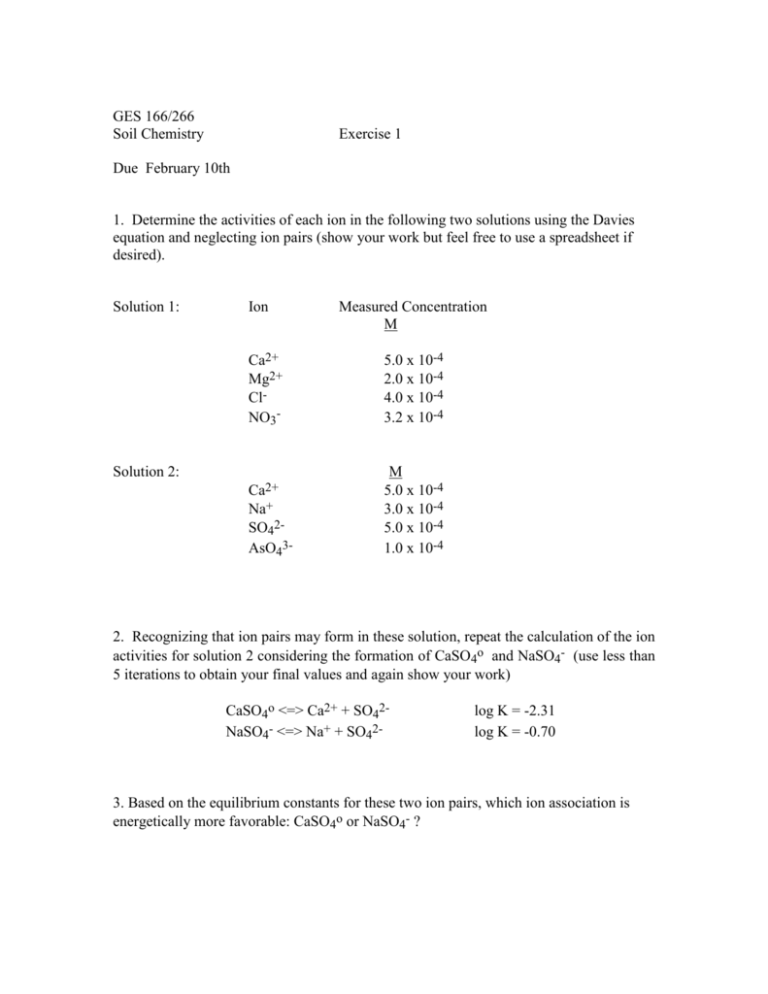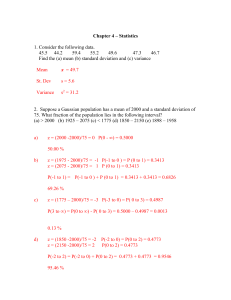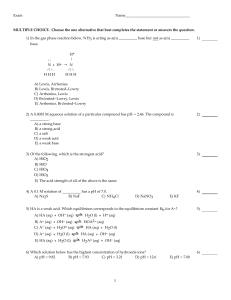Exercise 1: Carbonate and chemical speciation
advertisement

GES 166/266
Soil Chemistry
Exercise 1
Due February 10th
1. Determine the activities of each ion in the following two solutions using the Davies
equation and neglecting ion pairs (show your work but feel free to use a spreadsheet if
desired).
Solution 1:
Ion
Ca2+
Mg2+
ClNO3-
Solution 2:
Ca2+
Na+
SO42AsO43-
Measured Concentration
M
5.0 x 10-4
2.0 x 10-4
4.0 x 10-4
3.2 x 10-4
M
5.0 x 10-4
3.0 x 10-4
5.0 x 10-4
1.0 x 10-4
2. Recognizing that ion pairs may form in these solution, repeat the calculation of the ion
activities for solution 2 considering the formation of CaSO4o and NaSO4- (use less than
5 iterations to obtain your final values and again show your work)
CaSO4o <=> Ca2+ + SO42NaSO4- <=> Na+ + SO42-
log K = -2.31
log K = -0.70
3. Based on the equilibrium constants for these two ion pairs, which ion association is
energetically more favorable: CaSO4o or NaSO4- ?
For the following questions on carbonate equilibria, feel free to use appropriate
assumptions in species distribution unless otherwise noted. If you need to solve thirdorder or higher polynomial equations, employing a numerical procedure will be
necessary. The Newton-Raphson technique, shown in the box below, is an easy means to
accomplish this task.
Newton-Raphson Numerical Procedure
Xi+1 = Xi - {f(x) / f’(x)}
where f’(x) is the derivative of f(x). To solve a polynomial equation, make an estimate of
X; this gives you the first Xi. Compute f(x) and f’(x) with this guess, then subtract the
quantity { f(x) / f’(x)} from Xi. Use this next value to compute a new f(x) and f’(x);
again subtract the quantity { f(x) / f’(x)}. Repeat this process until you converge on an
answer.
4). In soils, active microorganism populations can lead to elevated levels of carbon
dioxide within microenvironments--often greater than ten times atmospheric levels. (a)
What are the concentrations of H2CO3*, HCO3-, and CO32- in a soil micropore where
PCO2 = 10-2.5, the pH is buffered by organic and mineral matter at a value of 7.6, and
calcite grains are present? (b) What would be the level of dissolved calcium within such
a micro-environment?
5) The carbonate system often has a dominant control on pH within alpine lakes. If an
alpine lake resides at high elevation and is thus in equilibrium with air having PCO2 =
10-4 atm, what is the pH of the water? (for this exercise, do NOT presume that the pH is
less than 9, although it may be in the end).
6) What would be the fractional (or percent) increase in carbon storage within the lake if
the level of carbon dioxide increased by a factor of ten to PCO2 = 10-3 atm?









